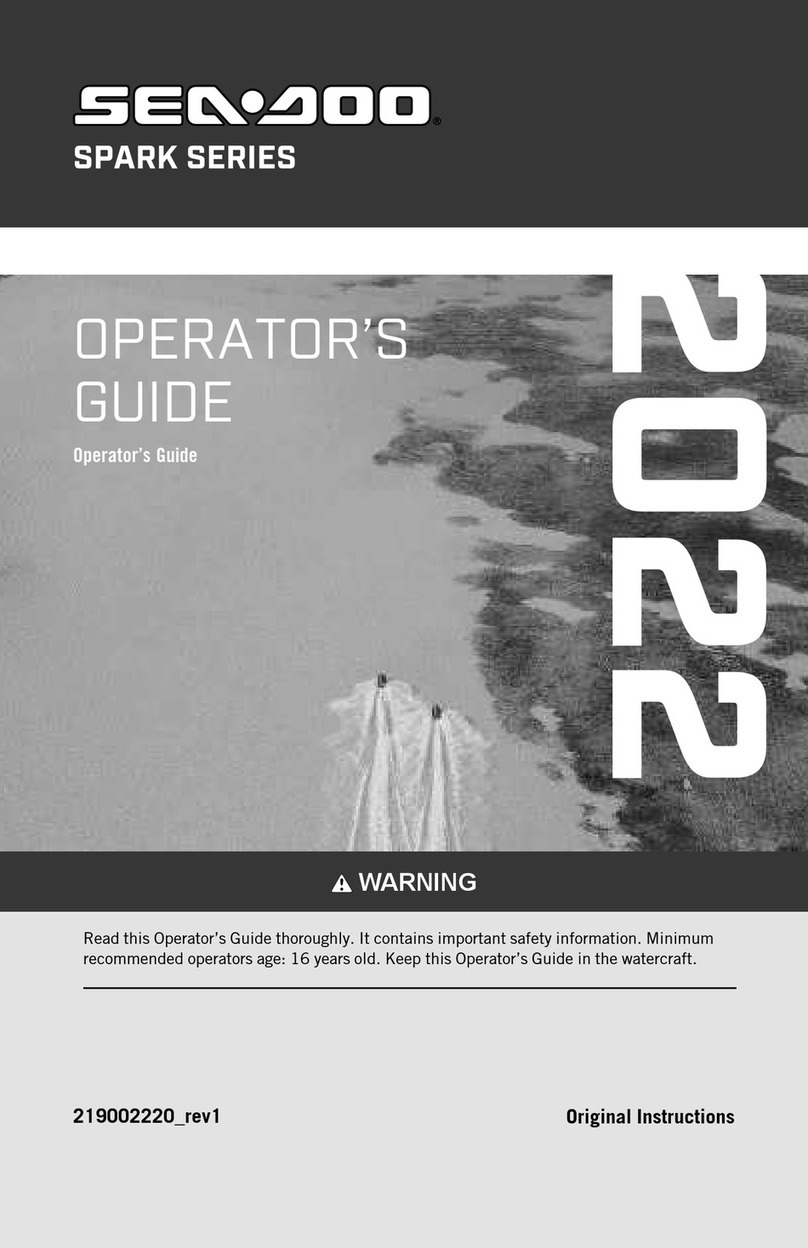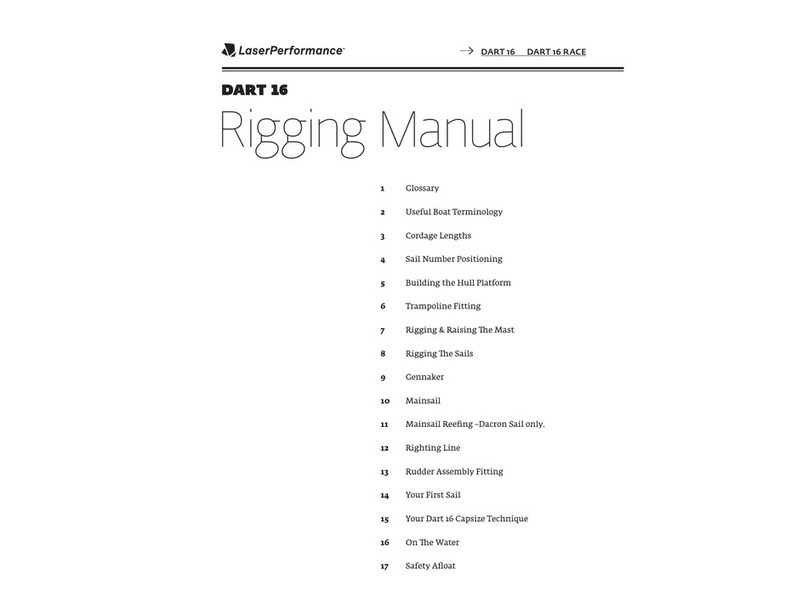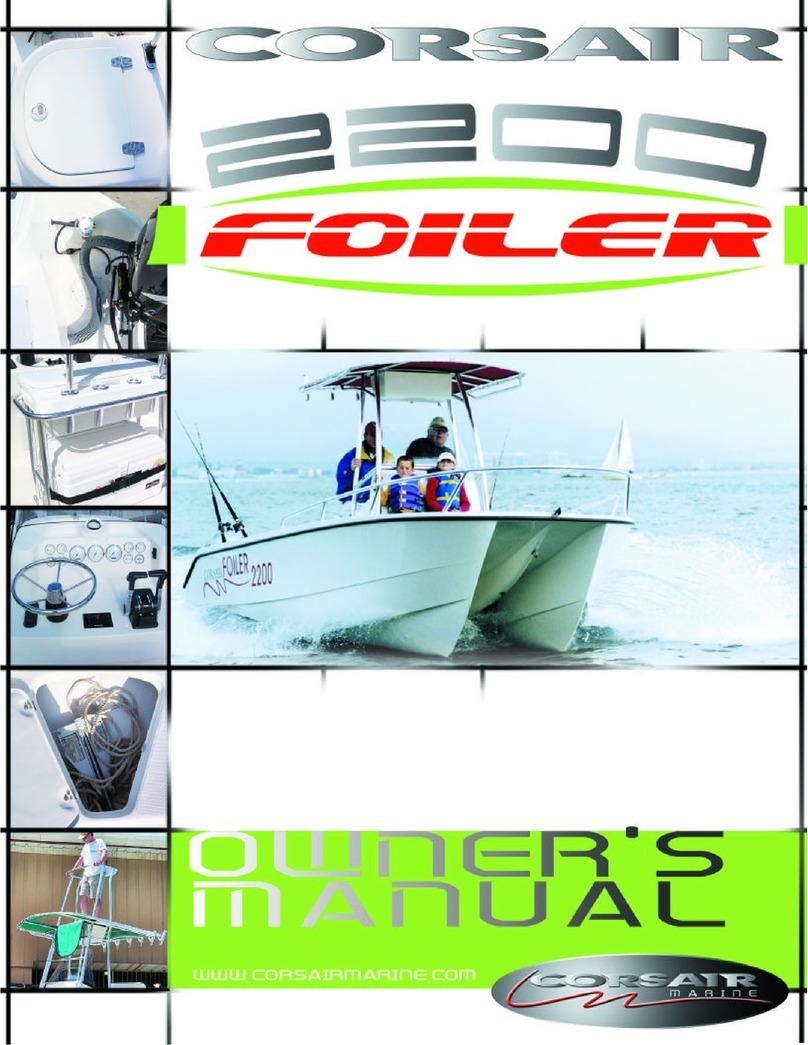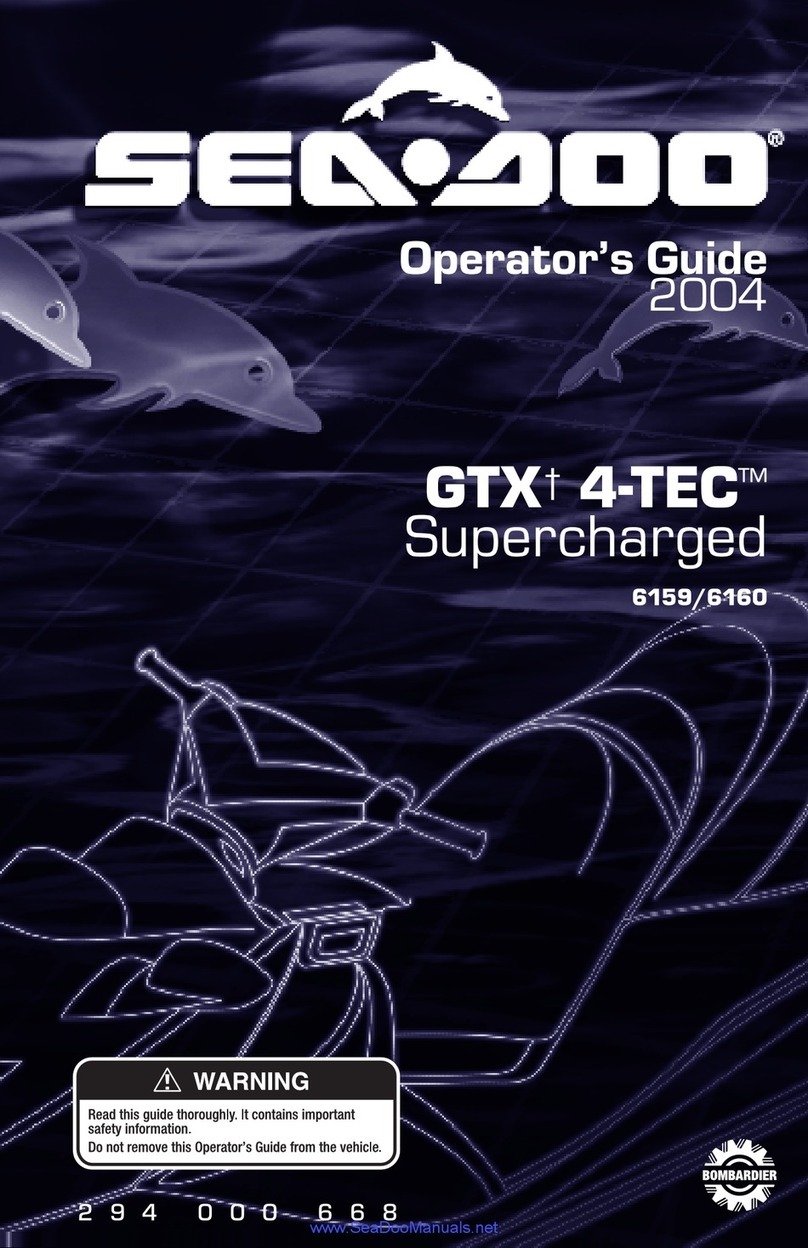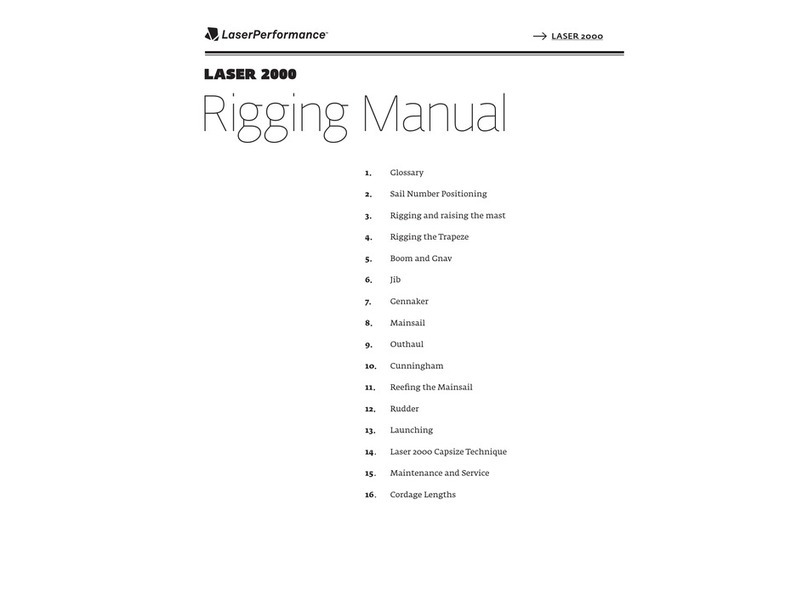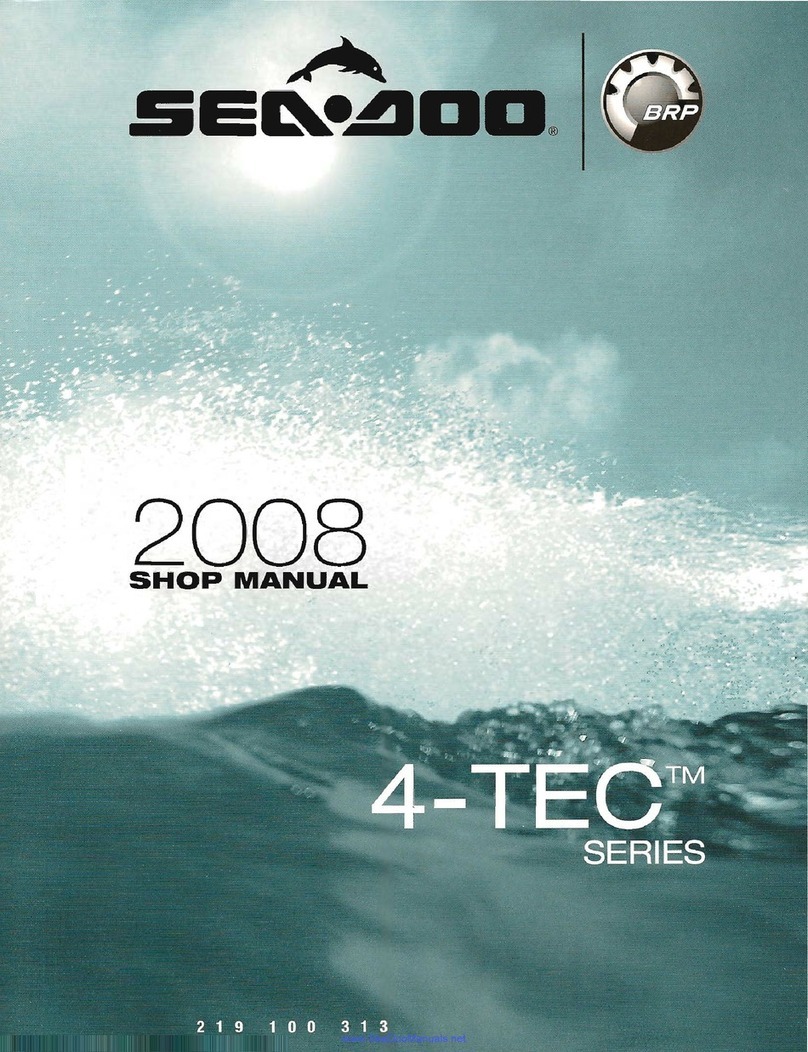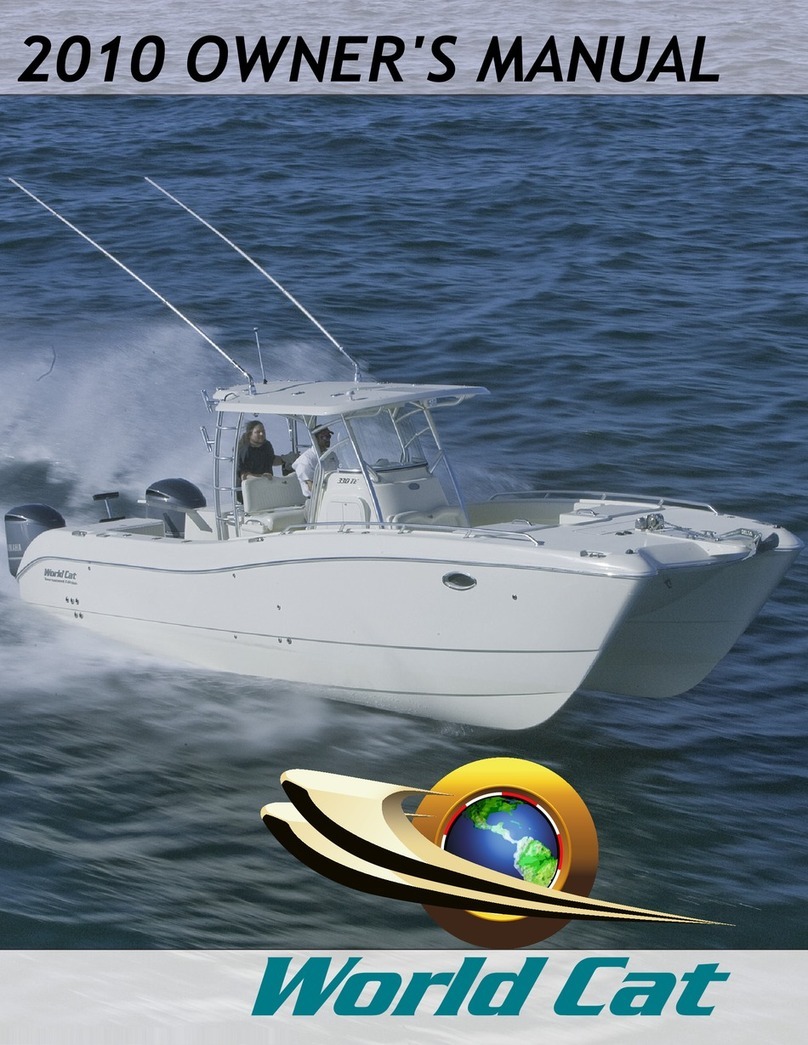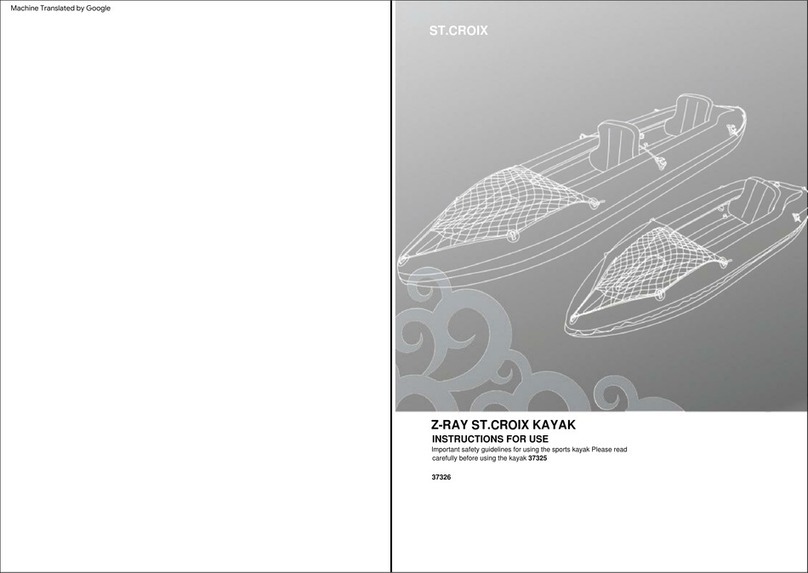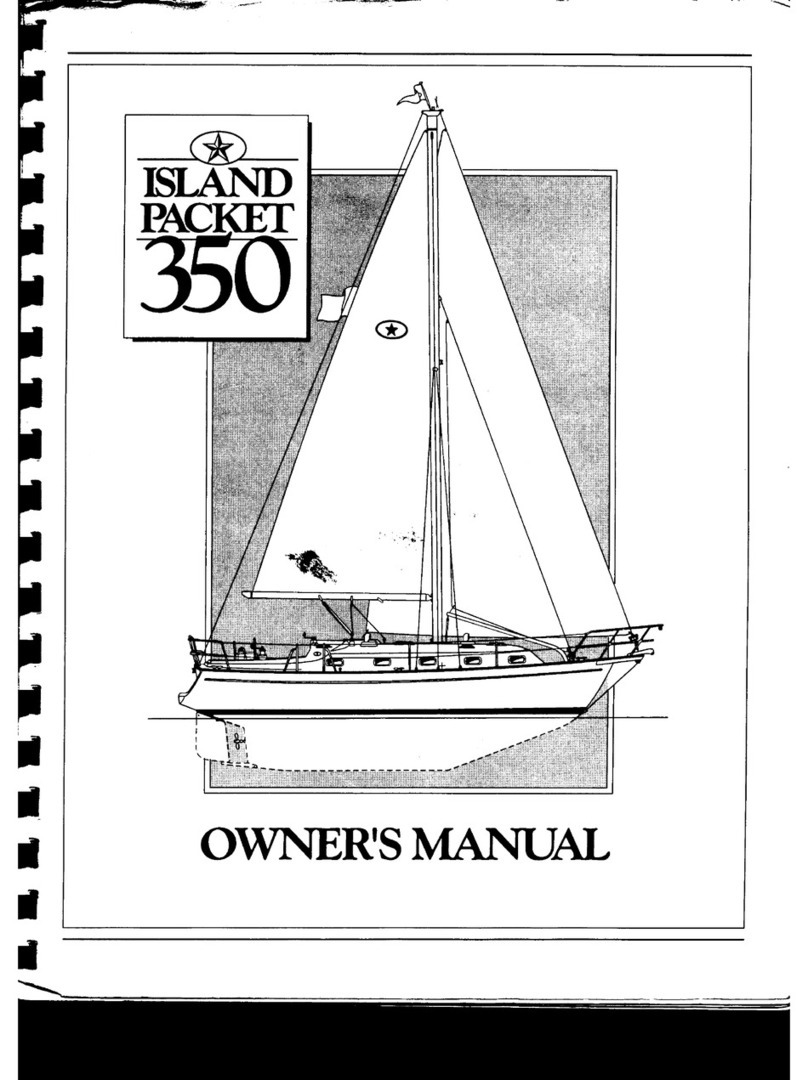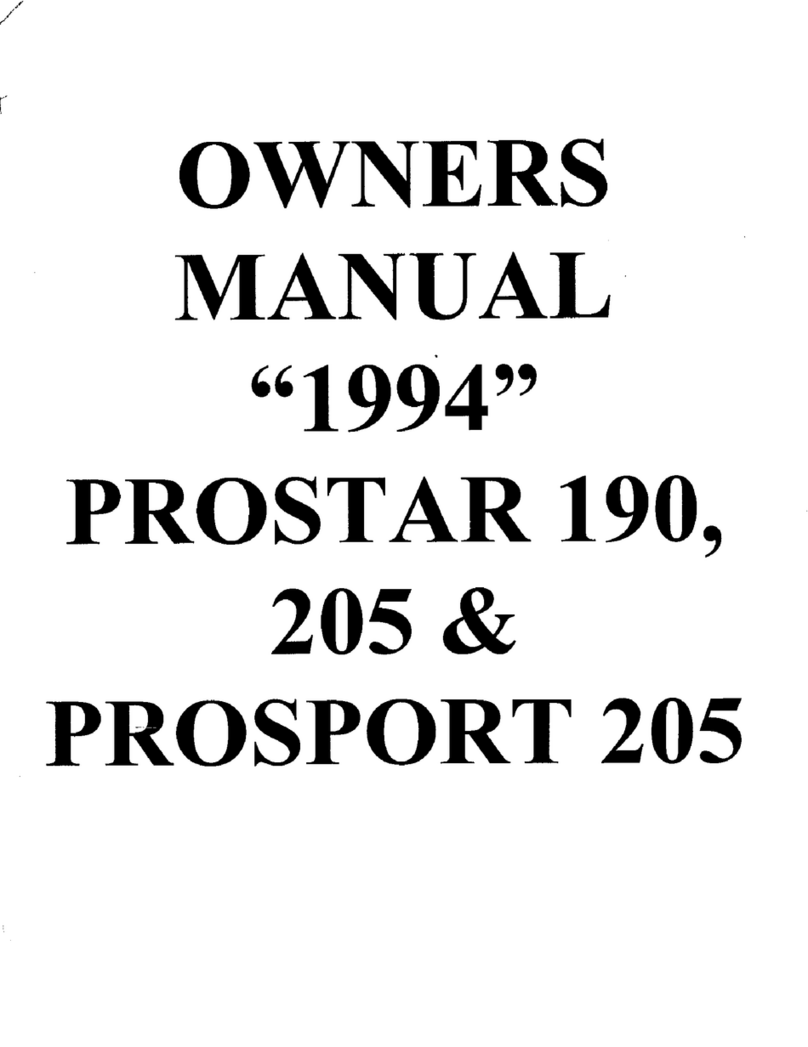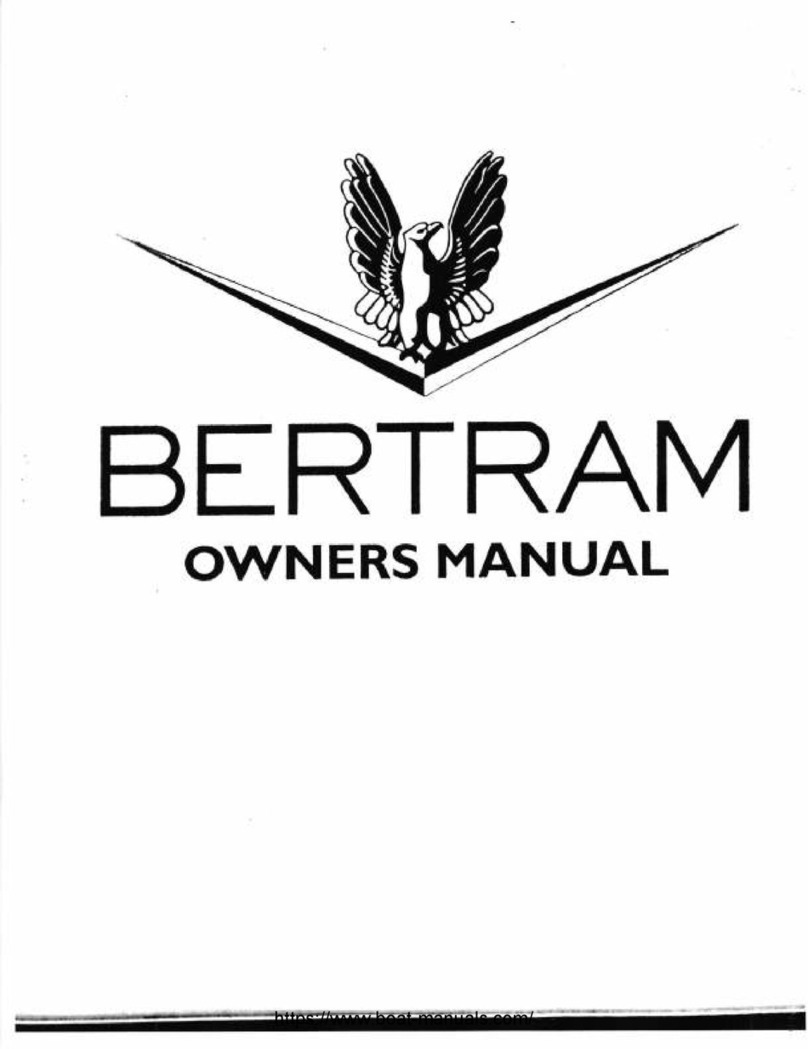Gibbs quadski User manual

WARNING! Please read this manual as it
contains important safety and operating
information.
Never allow anyone under 16 years old to ride
this amphibian.

QuadskiIX.fm Page 94 Tuesday, June 25, 2013 3:49 PM

Owner’s Manual
© 2014 Gibbs Sports Amphibians Inc.
All rights reserved. Information contained in this document is based on the latest information available at the time of
printing and is subject to the copyright and other intellectual property rights of Gibbs Sports Amphibians Inc. No part of
this document may be reproduced, stored in a retrieval system, or transmitted in any form or by any means, electronic,
mechanical, photocopying, recording, or otherwise. These materials must not be modified or reposted to other sites,
without the prior expressed written permission of the copyright holder.

Preface
Preface
Preface
Welcome to our Amphibious Family
At Gibbs Sports Amphibians Inc (GIBBS), we
strive to provide the world’s best High Speed
Amphibians (HSAs) for recreational and first-
responder use. A HSA is defined as a motor
vehicle able to travel under its own power on
both land and water at a speed of 15 mph
(24 km/h) or more with the transition between
land and water taking only a few seconds. We’ve
invested years of hard work and research to
create a new product that offers you award-
winning engineering, design and development of
an amphibian.
Our dedication to innovation and manufacturing
related to HSA technology provides an
incomparable high-performance machine for
consumer freedom and adventure.
Before using your Quadski (referred to as the
amphibian in this Owner’s Manual), please take
the time to get acquainted with your multi-use
personal sports amphibian. There is no other
product on the market like it today, so it’s
important to protect yourself and your
investment by following the instructions and
recommendations outlined in this Owner’s
Manual.
We recommend that you read this Owner’s
Manual before you ride your Quadski. This
Manual is full of facts and a detailed list of topics
that will give you an understanding of how to take
care of and safely ride a Quadski.
In order to maintain your Quadski, we urge you to
take responsibility for performing all pre-ride
inspections and other periodic checks outlined in
this Manual. This Manual contains instructions
for minor maintenance. However, it is imperative
that any major service, maintenance and
warranty items related to your amphibian be
performed at a GIBBS certified facility or your
point of sale dealership.
The Owner’s Manual should be considered a
permanent part of your amphibian and should
remain with the Quadski at all times (even when
sold). Please make sure to report any change of
address or ownership to GIBBS. This will allow
GIBBS to contact the current owner concerning
important product information and updates.
Because GIBBS strives to produce and
manufacture only high quality products, some
amphibians may not be the exact design as
described in this Owner’s Manual. Specifications
are subject to change without notice.
At GIBBS, we’ve taken great strides to insure
that you receive one of the first HSA technology
products that provides ultimate flexibility
between land and water. While operating your
Quadski it is essential to always wear required
safety equipment, stay on prepared trails and
respect all marine and wild life.
Thank you for choosing to be a part of the GIBBS
family; gear up and prepare for a redefined land
and water experience.
If you have any questions about safety
equipment, operation or maintenance of your
amphibian, please contact a GIBBS authorized
dealer or visit our website at:
www.gibbssports.com.
Wherever Adventure takes you, Think Safe and
Ride Responsibly
GIBBS

Contents
1
INTRODUCTION
About This Owner’s Manual ........................ 3
OPERATION
Rider Qualifications
Operator Training......................................... 4
Operator Age and Ability ............................. 4
No Alcohol or Drugs .................................... 5
No Passengers ............................................ 5
Important Safety Information
Avoid Carbon Monoxide (CO) Poisoning..... 6
Accessories and Modifications.................... 6
California Proposition 65 ............................. 6
Safety Labels
Warning Labels Affixed to the Amphibian ... 7
Fueling
Fuel Safety................................................. 12
Fuel Specification ...................................... 12
Fueling Procedure ..................................... 13
Controls
Overview.................................................... 14
Steering ..................................................... 15
Ignition Switch ........................................... 15
Starting the Engine .................................... 16
Engine Stop/Cut-off................................... 17
Throttle Lever............................................. 17
Selecting a Gear ........................................ 18
Braking (Land Mode Only)......................... 19
Parking Brake (Land Mode only) ............... 20
Instrument Cluster ..................................... 21
Suspension Retract/Deploy Switch........... 23
Headlights.................................................. 24
Equipment
Storage Compartments ............................. 25
Fire Extinguisher........................................ 25
Flag Mount................................................. 26
Front Eyelet................................................ 26
New Amphibian Break-In
New Amphibian Break-In........................... 27
Planning a Safe Trip
Plan Your Trip............................................ 28
Trips On Water........................................... 28
Trips On Land............................................ 28
What to Wear and Bring ............................ 29
Operating in Cold Weather........................ 31
Cargo and Load Limits .............................. 31
Pre-ride Inspection
Pre-ride Inspection .................................... 32
Safe Operation on Land
Riding Locations and Surfaces.................. 35
Speed......................................................... 37
Riding Position........................................... 37
Braking....................................................... 37
Turning....................................................... 38
Slopes........................................................ 38
Obstacles and Rough Terrain .................... 40
Reverse Operation ..................................... 41
No Stunts................................................... 41
No Towing Other Vehicles ......................... 41
Parking....................................................... 41
Recovering the Amphibian on Land .......... 42
Entering And Exiting The Water
Choosing Water Entry and Exit Sites......... 43
Entering the Water ..................................... 44
Exiting the Water........................................ 45
Safe Operation on Water
Important ................................................... 46
Learn About On-water Safety and
Waterway Rules ......................................... 46
Avoid Hazards While Engine is Running.... 46
Riding Position........................................... 46
Turning....................................................... 46
Marine Enhanced Steering......................... 47
Stopping .................................................... 47
Avoiding a Collision ................................... 48
Reverse Operation ..................................... 48
Water conditions........................................ 48
Crossing Waves and Wakes...................... 48
Shallow water ............................................ 49
Boarding the Amphibian in Deep Water .... 49
No Offshore Operation............................... 49
No Nighttime Operation............................. 49
No Anchoring............................................. 49
No Towing.................................................. 49
Practice Exercises ..................................... 50
Mooring/Docking ....................................... 51
Beaching ................................................... 52
Recovering the Amphibian on Water......... 52
Righting a Capsized Amphibian................. 53
Navigation Rules........................................ 54
After Your Ride
Post-operation ........................................... 56

Contents
2
Contents
MAINTENANCE
Maintenance Requirements
General Information ................................... 57
Scheduled Servicing .................................. 57
Owner Maintenance................................... 57
Maintenance Safety ................................... 58
Fuel and Emission Systems Components . 58
Maintenance Schedule .............................. 59
Owner Maintenance
Component Locations................................ 60
Air Filter...................................................... 61
Engine Oil................................................... 63
Engine Coolant........................................... 64
Brake Fluid ................................................. 65
Seat............................................................ 66
Upper Body Panel...................................... 67
Spark Plugs................................................ 68
Exhaust Spark Arrestor .............................. 69
Battery........................................................ 72
Fuses.......................................................... 73
Water Intake and Jet Impeller Cleaning..... 75
Hull Drain Plugs.......................................... 75
Wheels and Tires........................................ 76
Cleaning ..................................................... 77
Storage....................................................... 78
Removing Raw Water From The Quadski.. 79
Transporting............................................... 80
SPECIFICATIONS
Identification Numbers
Amphibian Identification Numbers............. 81
Engine Identification Number (EIN)............ 81
Emissions Control Information................... 82
Technical Data
Dimensions - On Land ............................... 83
Dimensions - On Water.............................. 84
Engine ........................................................ 85
Engine Management System ..................... 85
Transmission.............................................. 86
Jet Thrust Drive.......................................... 86
Electrical..................................................... 86
Wheels and Tires........................................ 87
Weights ...................................................... 87
Fluids And Capacities
Approved Fluids and Capacities................ 88

Introduction
3
Introduction
About This Owner’s Manual
This Owner’s Manual contains a great deal of
information about your amphibian. We advise
you to read it carefully and familiarize yourself
with the controls before riding.
For your own safety, follow the instructions and
warnings contained in this Manual. Ignoring
them could result in damage to the amphibian or
personal injury to you or others. Damage caused
by failure to follow instructions is not covered by
the Limited Warranty.
This Manual is printed on waterproof paper so
that it can be stored in the front storage box of
the amphibian and be available for reference if
required. Should you resell your amphibian,
remember to pass on this Manual to the next
owner.
Signal words and symbols used in this
manual
The following signal words and symbols are used
in this Manual to designate safety messages and
other important information.
WARNING! Indicates a hazardous
situation which, if not avoided, could
result in serious injury or death.
CAUTION! Indicates a hazardous
situation which, if not avoided, could
result in minor or moderate injury.
NOTICE Used to address practices or situations
not related to physical injury, or to prevent
possible damage to the amphibian.
This symbol identifies instructions that
should be observed in order to minimize
damage to the environment.
Status at time of printing
All specifications and descriptions are accurate
at the time of printing. Gibbs Sports Amphibians
Inc operates a policy of continuous product
development and improvement and reserves the
right to change specifications without notice.
Copyright © 2014 Gibbs Sports Amphibians Inc.
No part of this publication may be reproduced,
stored in a data processing or retrieval system, or
transmitted in any form by electronic,
mechanical or other means, or recorded,
translated, expanded, edited or abridged without
the prior written permission of the copyright
holder.

Rider Qualifications
4
Rider Qualifications
OPERATIONRider Qualifications
Operator Training
WARNING! The amphibian is not a toy
and can be hazardous to operate.
Disregarding any of the safety
precautions and instructions contained
in this Owner’s Manual or on the safety
labels attached to the amphibian could
cause injury including the possibility of
death!
Please read this Owner’s Manual and familiarize
yourself with the amphibian before operating.
This manual has sections regarding:
Planning a Safe Trip, page 28
Pre-ride Inspection, page 32
Safe Operation on Land, page 35
Entering And Exiting The Water, page 43
Safe Operation on Water, page 46
Observe the instructions on all safety labels.
They are there to help you safely enjoy the use of
your amphibian.
The handling characteristics and performance of
the amphibian on land and water may be
different than other ATVs and watercraft you have
used. Please take the time to practice maneuvers
in a safe environment even if you consider
yourself as an experienced rider.
Never use the amphibian unless you have
received proper training or instruction. Gibbs
Sports Amphibians Inc highly recommends that
you take an ATV rider safety course and a safe
boating course. Please check with a Gibbs
Sports Amphibians dealer or local authorities for
availability in your area. Call 1-800-887-2887 to
find out about an ATV training course near to you.
To find a safe boating course near you, visit:
www.uscgboating.org/
In certain areas, an operator competency card is
mandatory to operate the amphibian on water.
Completion of an ATV rider safety course is also
mandatory before operation in some areas.
Ensure that you are familiar with local and federal
laws and regulations concerning the off-road
riding areas and waterways that you are
intending to use.
Operator Age and Ability
Never allow anyone under the age of 16 to
operate the amphibian.
Laws regarding the minimum age and licensing
requirements of operators may vary from one
area to another. Be sure to contact the local
authorities for information regarding the legal
operation of the amphibian for your area.
Do not allow a person to operate the amphibian
if they have an impairment that may prevent them
operating it safely (for example, impaired
judgment, vision, reaction time or the ability to
operate the controls). This includes temporary
impairments such as fatigue.
Only attempt maneuvers and ride in situations
that are suitable for your level of riding ability and
experience. Maneuvers or situations that are too
challenging increase the risk of an accident.

Rider Qualifications
5
No Alcohol or Drugs
Never operate your amphibian under the
influence of alcohol or drugs, including
medications that affect your ability to operate
motor vehicles.
Like driving a car, driving the amphibian requires
the rider to be sober, attentive and alert.
Operating the amphibian while intoxicated or
under the influence of drugs is not only
dangerous, but also illegal.
The use of drugs and alcohol decreases reaction
time, impedes judgment, impairs vision, affects
balance and perception which could inhibit your
ability to safely operate the amphibian.
No Passengers
Never carry passengers. The amphibian is
designed for use by the rider only.
The additional weight of a passenger will affect
the amphibian’s stability and maneuverability
which will increase the chance of you losing
control.
Note: The long seat is designed to allow the rider
to change body positions while riding.

Important Safety Information
6
Important Safety Information
Important Safety Information
Avoid Carbon Monoxide (CO)
Poisoning
Engine exhaust fumes contain carbon monoxide,
a deadly gas. Breathing carbon monoxide can
cause headaches, dizziness, drowsiness,
nausea, confusion and eventually death.
Carbon monoxide is a colorless, odorless,
tasteless gas that may be present even if you do
not see or smell any engine exhaust. Deadly
levels of carbon monoxide can collect rapidly,
and you can quickly be overcome and unable to
save yourself. Also, deadly levels of carbon
monoxide can linger for hours or days in
enclosed or poorly ventilated areas. If you
experience any symptoms of carbon monoxide
poisoning, leave the area immediately, get fresh
air and seek medical treatment.
To prevent serious injury or death from carbon
monoxide:
Never run the vehicle in poorly ventilated or
partially enclosed areas such as garages,
carports or barns. Even if you try to ventilate
engine exhaust fumes with fans or open
windows and doors, carbon monoxide can
rapidly reach dangerous levels.
Never run the vehicle outdoors where engine
exhaust fumes can be drawn into a nearby
building through openings such as windows
and doors.
Never stand behind the amphibian while the
engine is running. A person standing behind
a running amphibian may inhale high
concentrations of exhaust fumes.
Accessories and Modifications
The installation of non-approved parts and
accessories, or any non-approved modification
to your amphibian, may be dangerous and could
affect the handling of the amphibian and the
safety of the rider. It may also invalidate the terms
and conditions of the Limited Warranty.
It is extremely hazardous to fit parts or
accessories where installation requires the
dismantling of, or addition to, either the electrical
or fuel systems.
Consult a Gibbs Sports Amphibians dealer
before installing any parts or accessories and
before making any modification to the
amphibian.
California Proposition 65
WARNING! Certain components used in
the amphibian contain or emit chemicals
known to the State of California to cause
cancer and birth defects or other
reproductive harm. In addition, certain
fluids contained in the amphibian and
certain products of component wear
contain or emit chemicals known to the
State of California to cause cancer and
birth defects or other reproductive harm.

Safety Labels
7
Safety Labels
Warning Labels Affixed to the Amphibian
The following illustration show the locations of all the safety labels located on your amphibian. Read all
safety labels before operating and always observe all instructions on the labels. If any label is missing
or damaged, please contact a Gibbs Sports Amphibians dealer to have the label replaced.

Safety Labels
8
Safety Labels
Label 1
Label 2
Label 3
Label 4
Label 5
Label 6
Label 7 (US and Canada)

Safety Labels
9
Label 7 (Europe)
Label 8
Label 9
Label 10
Label 11
Label 12
Label 13

Safety Labels
10
Safety Labels
Label 14
Label 15
Label 16

Safety Labels
11
Label 17
Label 18
Label 19
Label 20

Fueling
12
Fueling
Fueling
Fuel Safety
WARNING! Gasoline vapors are highly
flammable, have a low flash point and are
explosive, especially in confined spaces.
Avoid exposing the vapors to any
potential sources of ignition as the
resulting fire and explosion may cause
serious injuries and/or death.
WARNING! Switch off the engine when
refueling, as it is both a source of
extreme temperatures and electrical
sparks. Failure to do so may cause a fire
or explosion.
WARNING! Do not smoke, use an open
flame or cause sparks while refueling.
The resulting fire and/or explosion may
cause serious injury or death.
WARNING! Only use containers
specifically designed for carrying fuel,
failure to do so may result in spillage and
cause a fire.
WARNING! Do not overfill the fuel tank.
Overfilling may cause spillage when the
amphibian is driven. Spillage may also
occur if the fuel expands in high ambient
temperatures.
WARNING! Do not start the amphibian if
spilled gasoline or gasoline vapor is
present.
Fuel Specification
NOTICE Do not use non-recommended fuels,
leaded fuels, lead substitutes or fuel additives -
these can cause damage to the engine, fuel and
emission control systems. In addition:
Fuel system cleaning agents should not be
used as they may be harmful to fuel system
components on your vehicle.
If the fuel tank is filled with the wrong type of
fuel, do not start the engine. It is essential
that you seek qualified assistance. Running
the engine can cause serious engine and fuel
system damage.
Never use fuel containing more than 10%
ethanol or methanol. The use of a
non-recommended fuel can result in
decreased engine performance and damage
to critical parts in the fuel system and engine.
Only use a Premium unleaded fuel, see
Engine, page 85.
Note: Even a very small quantity of leaded
fuel will damage your vehicle's emission
control system and could invalidate the
emissions warranty.
Fuel tank capacity
NOTICE Avoid running out of fuel. Doing so can
cause damage to the vehicle’s engine, fuel pump
and emission control systems.
Total tank capacity 15 U.S. gallons
(56.5 liters)

Fueling
13
Fueling Procedure
WARNING! In warm temperatures the
fuel tank may be pressurized, take care
when removing the filler cap as fuel
vapors may be released.
NOTICE Refueling on water is not
recommended; if possible always refuel on land.
With the amphibian stationary and the engine off,
slowly unscrew the fuel filler cap and allow the
vapors to vent.
Note: A chain secures the fuel filler cap to the
amphibian to prevent loss.
The filler tube accepts a narrow filler nozzle of the
type found on pumps that deliver unleaded fuel.
Fill the tank slowly until the filler nozzle cuts off
the fuel supply. Do not attempt to fill the tank
beyond this point, or spillage could result due to
expansion of the fuel.
When replacing the fuel filler cap, insert the
retaining chain into the filler neck and tighten the
cap until it clicks three times.
Emergency refueling
WARNING! It is possible to overfill the
tank if a fuel dispensing pump is not used
(e.g. portable fuel containers).
If, in an emergency, you have to refuel the
amphibian from a source other than a filling
station, check the specification of the fuel before
refueling, and be careful not to overfill.
If you do have to refuel while on water,
make every effort to avoid fuel spillage.
Fuel can be very damaging to a marine
environment.

Controls
14
Controls
Controls
Overview
1. Brake lever (Land mode only)
Rear brake lever - European spec Quadski
2. Reverse button (Land mode only)
3. Gear selection (Land mode only)
4. Engine start button
5. Instrument cluster
6. Throttle lever
7. Front brake lever - European spec Quadski
8. Engine stop/safety cut-off button
9. Reverse lever (Marine mode only)
10. Headlight switch (Land mode only)
11. Ignition switch
12. Suspension Deploy/Retract switch

Controls
15
Steering
WARNING! To avoid pinching body parts,
never turn the handlebars while someone
is near the jet thrust nozzle.
The handlebars control the direction of the
amphibian when it is being operated on Land and
Water.
On land, the handlebars turn the front wheels for
direction required.
Note: The jet nozzle also moves (in the opposite
direction to the wheels) when turning on land.
On water, the handlebars move the jet thrust
nozzle to direct the water output in the direction
you want to turn the amphibian.
Note: When operating in reverse, you will need to
turn the handlebars in the opposite direction to
the direction you want to travel.
Ignition Switch
WARNING! Do not turn the ignition
switch to the ‘Lock’ position while the
amphibian is in motion - the steering lock
will engage, making it impossible to steer
the amphibian.
Lock
Turn the handlebars all the way to the left or
right then turn the key counterclockwise to
engage the steering head lock. No electrical
circuits function.
Off
No electrical circuits function.
On
Turn the key fully clockwise to the ‘On’
position. The amphibian powers up and the
instrument cluster illuminates.
Note: The key can be removed in both the ‘Lock’
and ‘Off’ positions.
Note: An audible tone (three beeps) will sound
shortly after the engine has stopped if the key has
not been removed.

Controls
16
Controls
Starting the Engine
WARNING! Never start or leave the
engine running in an unventilated
building - exhaust gases contain carbon
monoxide, which can cause
unconsciousness and may even be fatal.
WARNING! Gasoline vapors can
explode. Before starting the engine,
operate the ventilation blower for 4
minutes by turning the ignition key to the
ON position. Remove the seat and check
the engine compartment for gasoline
vapors.
WARNING! Never operate the amphibian
if the battery does not have sufficient
power to start the engine or shows other
signs of decreased power (for example,
long or slow engine cranking). Loss of
battery power when riding could leave
you stranded.
To start the engine:
1. Insert the key in the ignition switch and turn
the key to the On position. A buzzer will
briefly sound to indicate that the ignition is
On.
2. Check that the steering column lock has
disengaged by moving the handlebars from
left to right.
3. Make sure the engine safety cut-off is
inserted under the engine off button and that
the lanyard is secured to your wrist or your
personal flotation device (PFD). If the rider
falls off the amphibian the engine will stop
when the safety cut-off is removed.
4. Make sure the throttle lever is not pressed.
5. When on land, apply and hold the brake
lever(s).
6. Press and hold the engine start button until
the engine is running.
7. Release the start button once the engine has
started.
WARNING! When the engine is started,
gear 1 is automatically selected. Do not
rev the engine when the amphibian is
stationary.
WARNING! The jet impeller runs
whenever the engine speed exceeds
2000 rpm irrespective of whether the
amphibian is on land or water. Keep
others away from the intake grate and jet
nozzle when the engine is running.
Note: In cold conditions, the engine start time will
increase.
Table of contents



